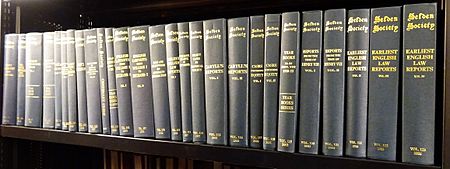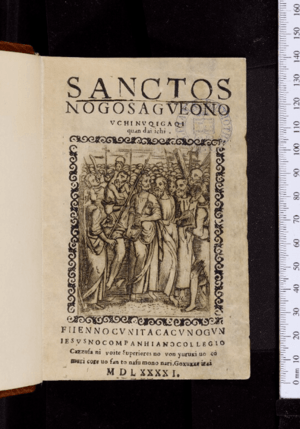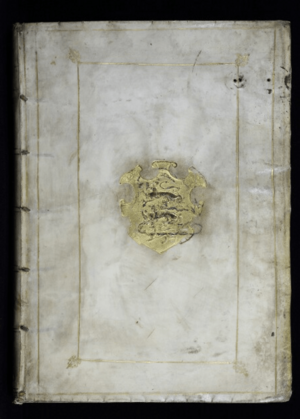John Selden facts for kids
Quick facts for kids
John Selden
|
|
|---|---|

John Selden: portrait by an unknown artist
|
|
| Born | 16 December 1584 Salvington, Sussex
|
| Died | 30 November 1654 (aged 69) White Friars, London
|
| Era | 17th-century philosophy |
| Region | Western philosophy |
| School | Natural law, social contract, humanism |
|
Main interests
|
Political philosophy, legal history |
|
Notable ideas
|
Proposed an egoistic theory of moral motivation, maintained that natural law was revealed historically through (esp. Hebrew) scripture, argued that civil law arises from contract |
|
Influences
|
|
John Selden (born December 16, 1584 – died November 30, 1654) was an important English expert in law. He studied England's old laws and government, and also Jewish law. People called him a polymath, which means he knew a lot about many different subjects. A famous writer, John Milton, once said in 1644 that Selden was "the chief of learned men" in England.
Contents
Early Life and Education
John Selden was born in a small village called Salvington in West Sussex. He was baptized at the local church, St Andrew's Church, West Tarring. Sadly, the cottage where he was born was destroyed by fire in 1959.
His father, also named John Selden, was a farmer. His mother, Margaret, came from a more important family. John Selden went to a free grammar school in Chichester. In 1600, he started studying at Hart Hall at Oxford University.
After Oxford, he moved to London to study law. In 1603, he joined Clifford's Inn, and then in 1604, the Inner Temple. He became a lawyer in 1612. One of his first supporters was Sir Robert Bruce Cotton, who was an expert in old documents. Selden helped him by copying old government records from the Tower of London. Even though he was a lawyer, Selden rarely went to court. Instead, he worked behind the scenes, helping people with legal documents and advice. This work was very successful and earned him a lot of money.
From Law Scholar to Politician

In 1618, Selden published a book called History of Tithes. This book was about the history of tithes, which were payments (often 10% of income) made to the church. Even though the book was approved, it worried the bishops and even King James I. Selden was called before the King's advisors, the Privy Council. He was forced to take back his ideas and was not allowed to write replies to anyone who disagreed with him.
This event pushed Selden into politics. Even though he was not a member of Parliament of England yet, he helped write the Protestation of 1621. This document was a strong statement from the House of Commons about their rights. Because of this, Selden and others were put in prison. He used his time in prison to prepare a new edition of a history book by a medieval writer named Eadmer.
A Voice in Parliament
In 1623, Selden was elected to the House of Commons for Lancaster. He worked on important committees. He was also asked to teach law at Lyon's Inn, but he refused. Because of this, he was fined and temporarily banned from being a leader at the Inner Temple. However, he later became a Master of the Bench there.
In 1626, he was elected to Parliament again for Great Bedwyn. He played a big part in trying to remove George Villiers, 1st Duke of Buckingham from power. The next year, he defended Sir Edmund Hampden in a famous court case called Darnell's Case.
In 1628, Selden was elected for Ludgershall. He helped create the Petition of Right, a very important document that limited the King's power. In 1629, he was involved in a strong protest in the House of Commons against unfair taxes. Because of this, he was sent back to the Tower of London for eight months. He was later moved to the Marshalsea prison. Eventually, Archbishop Laud helped him get released.
After his release, Selden went to live with Henry Grey, 8th Earl of Kent, whose legal advisor he was. He was not elected to the Short Parliament in 1640. However, he was easily elected to the Long Parliament for Oxford University later that year.
Selden disagreed with some ideas that led to bishops being removed from the House of Lords. He also supported the Commons' statement to protect the Protestant religion, the King's power, and people's freedom. He was against both the King and Parliament on some issues. In the end, he supported Parliament against King Charles I. He believed the King was definitely breaking the law, but he was less sure if Parliament was doing the same.
In 1643, Selden joined the Westminster Assembly, a group that discussed church matters. He had views that some people, like George Gillespie, disagreed with. Selden believed the government should have power over the church, a view called Erastianism.
In 1643, Parliament put Selden in charge of the records at the Tower of London. In 1645, he was asked to be the head of Trinity Hall, Cambridge, but he said no. In 1646, he agreed to the Solemn League and Covenant, a pact between England and Scotland. In 1647, Parliament gave him £5000 as payment for his troubles under the King.
Later Life and Legacy
After the Earl of Kent died in 1639, Selden lived with the Earl's widow, Elizabeth Talbot. Many believe they secretly married.
Selden built a famous library with thousands of books and manuscripts. After his death in 1654, this collection became part of the Bodleian Library at Oxford University. He died in London on November 30, 1654, and was buried in the Temple Church. His tomb can still be seen there through glass plates in the floor.
His Many Writings
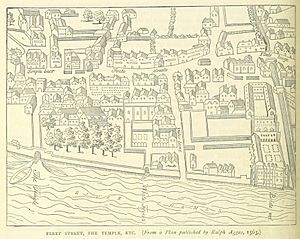
John Selden was known for writing many books and papers. His early works focused on English history.
Books on English History
In 1610, he published three books: Jani Anglorum Facies Altera, England's Epinomis, and The Duello, or Single Combat. These books explored English law and the history of trial by combat. In 1613, he wrote notes for a long poem called Poly-Olbion by Michael Drayton. In 1614, he published Titles of Honor, a detailed work about noble titles. This book was updated in 1631 and earned him the nickname "monarch of letters" from his friend, the writer Ben Jonson.
His controversial History of Tithes came out in 1618. In it, Selden argued that tithing (payments to the church) was based on civil law, not church law. He also looked at old Jewish customs about tithes. This book was important because it combined old records with historical storytelling.
In 1623, he published an edition of Eadmer's Historia Novarum. This book was special because it included information from the Domesday Book, which was not widely available at the time.
Studies on the Near East and Judaism
In 1617, Selden published De dis Syris, which made him famous as an expert on Eastern cultures. This book was important for its early use of comparing different mythologies. In 1642, he published part of an Arabic history book.
He also wrote books about Jewish law and customs. These included De successionibus in bona defuncti secundum leges Ebraeorum and De successione in pontificatum Ebraeorum, both published in 1631.
In 1640, he published De jure naturali et gentium juxta disciplinam Ebraeorum. This book was about natural law, which are rules believed to be based on human nature. John Milton praised this work, saying it showed how all ideas, even mistakes, can help find the truth. Selden's book also talked about international law based on the Seven Laws of Noah.
He continued to write about Jewish topics, including a book on the Jewish calendar in 1644 and a book on marriage and divorce among Jews in 1646.
International Law and Mare Clausum

Selden's book Mare clausum (meaning "closed sea") was written to argue against the ideas of Hugo Grotius. Grotius had written The Free Sea (Mare liberum), which argued that the seas should be open to everyone. Selden's book, however, argued that England had rights over the waters near its coasts, especially to stop Dutch fishermen from fishing there.
Selden wrote Mare clausum many years before it was published in 1635. King James I had stopped its publication for political reasons. When it finally came out, it was with the support of King Charles I. This suggests that Selden might have been leaning more towards the King's side during the early 1630s.
Works Published After His Death
Several of Selden's smaller works were printed after he died. This includes a paper defending the celebration of Christmas, which was banned during the time of the Puritan Commonwealth (1649–1660). A collection of his writings was published in 1725.
His most famous work, Table Talk, was published in 1689. It was put together by his assistant, Richard Milward. Milward said that the ideas and most of the words were Selden's.
Selden's Ideas
Selden believed that the government should have power over the church. This idea is called Erastianism. He also believed in free will, which meant people could make their own choices. This was different from some other beliefs at the time.
He was also a bit doubtful about the popular stories of King Arthur, though he thought Arthur probably existed. He suggested that the Druids were ancient, wise thinkers.
Remembering John Selden
John Selden is honored by the Selden Society, a group founded in 1887 that studies English legal history.
He is also remembered in place names in Salvington, like "The John Selden Inn" and Selden Road. There is also The Selden Arms in Worthing.
His Impact
Historians say that Selden was very important in changing how English history was written. He helped move it from just collecting old facts to a more modern way of understanding history. He was considered one of the most learned men of his time.
Around 1640, Selden's ideas, along with those of Grotius, influenced a group of thinkers known as the Great Tew circle. It was here that Selden met and became friends with Thomas Hobbes, another famous philosopher. They had similar ideas about politics.
Richard Cumberland followed Selden's ideas on natural law. Selden argued that rules needed a higher authority to be truly binding.
Giambattista Vico, a famous Italian philosopher, called Grotius, Selden, and Samuel Pufendorf the "three princes" of natural law among nations.
Selden's Library Collection
When John Selden died in 1654, he had collected thousands of manuscripts and printed books. His will suggested that he wanted to give most of his important books and manuscripts to the Bodleian Library at Oxford. Some believed he wanted to give other books to the Inner Temple, but they didn't have a big enough library.
In 1659, Selden's executors (the people in charge of his will) arranged for his entire collection to go to the Bodleian Library. They asked that his books be kept together as "Mr. Selden’s Library." The Bodleian agreed, and the collection arrived in June 1659.
Selden's collection was the largest the Bodleian received in the 1600s, with about 8,000 items. Any duplicate books (books the library already had) were given to Gloucester Cathedral library. There was a rumor that some of his books left in London were destroyed in a fire. It took several years to fully organize and list all of Selden's books at the Bodleian.
The Selden collection at the Bodleian has over 400 manuscript volumes. These manuscripts show Selden's interest in many different languages, including:
- Russian
- Greek
- Arabic
- Hebrew
- And even languages from the New World, like Mexican hieroglyphics.
Many manuscripts are about law, both English and international. These include:
- A part of a book on Islamic law.
- Books on Canon law (church law).
- A record of the laws of Ivan the Terrible.
- Various legal topics, like maritime law.
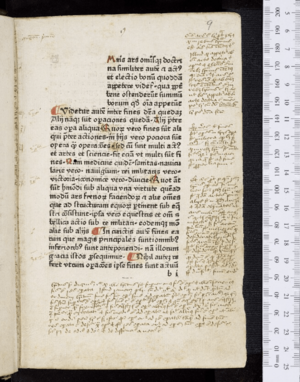
Some manuscripts even talk about events from Selden's time. For example, one has a Latin speech given in Oxford when Prince Charles returned from Spain in 1623. Others contain classic works of philosophy and literature, such as books by Aristotle and Aeschylus.
Among the printed books in the Selden collection is the first book ever printed in Japan using movable type. Many of the books in Selden's collection also came from the libraries of other famous people, like Sir Robert Cotton and John Donne. Some books from John Donne's library even have notes from both men.


